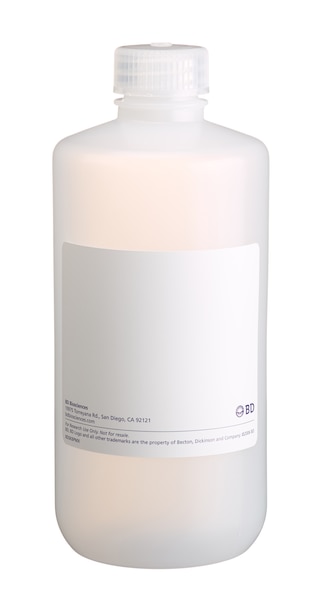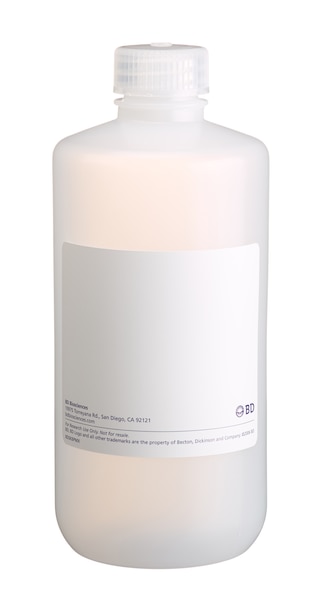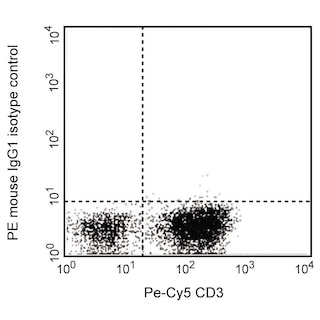Old Browser
This page has been recently translated and is available in French now.
Looks like you're visiting us from {countryName}.
Would you like to stay on the current country site or be switched to your country?


.png)

Flow cytometric analysis of mouse IL-23 Receptor (IL-23R) expression on IL-23R-non-transfected and IL-23R transfected cells. Mouse IL-23R-non-transfected (Left Panel) and IL-23R-transfected (Right Panel) cells were stained with either PE Mouse IgG1, κ Isotype Control (Cat. No. 554680, dashed line histogram) or PE Mouse anti-Mouse IL-23 Receptor (Cat. No. 562468; solid line histogram). Flow cytometric fluorescence histograms showing the expression of IL-23R (or Ig Isotype Control staining) were derived from gated events with the forward and side light-scatter characteristics of viable cells. Flow cytometry was performed using a BD™ LSR II Flow Cytometer System.
.png)

BD Pharmingen™ PE Mouse anti-Mouse IL-23 Receptor
.png)
Regulatory Status Legend
Any use of products other than the permitted use without the express written authorization of Becton, Dickinson and Company is strictly prohibited.
Preparation And Storage
Product Notices
- Since applications vary, each investigator should titrate the reagent to obtain optimal results.
- An isotype control should be used at the same concentration as the antibody of interest.
- Caution: Sodium azide yields highly toxic hydrazoic acid under acidic conditions. Dilute azide compounds in running water before discarding to avoid accumulation of potentially explosive deposits in plumbing.
- For fluorochrome spectra and suitable instrument settings, please refer to our Multicolor Flow Cytometry web page at www.bdbiosciences.com/colors.
- Please refer to www.bdbiosciences.com/us/s/resources for technical protocols.
Companion Products



The 3C9 monoclonal antibody specifically binds to the mouse Interleukin-23 Receptor (IL-23R) subunit that is encoded by the il23r gene. The IL-23R subunit is a type I transmembrane glycoprotein and member of the hemopoietin receptor superfamily. The mouse IL-23 Receptor complex is comprised of IL-23R and IL-12 receptor beta 1 (IL-12Rβ1) subunits. The IL-23R complex can bind IL-23, a cytokine that plays roles in innate and adaptive immunity as well as in autoimmune diseases, eg, by the generation and maintenance of Th17 cells. Mouse IL-23R is expressed by activated/memory CD4+ T cells, Th1, Th2 and Th17 cells, γδ T cells, dendritic cells and macrophages as determined by IL-23R mRNA expression and IL-23R-GFP reporter mouse studies. The IL-23-bound IL-23R complex transduces an intracellular signal pathway mediated by a Jak-STAT signaling cascade.

Development References (6)
-
Awasthi A, Riol-Blanco L, Jager A, et al. Cutting edge: IL-23 receptor gfp reporter mice reveal distinct populations of IL-17-producing cells. J Immunol. 2009; 182(10):5904-5908. (Biology). View Reference
-
Jones LL, Alli R, Li B, Geiger TL. Differential T Cell Cytokine Receptivity and Not Signal Quality Distinguishes IL-6 and IL-10 Signaling during Th17 Differentiation.. J Immunol. 2016; 196(7):2973-85. (Biology). View Reference
-
Lankford CS, Frucht DM. A unique role for IL-23 in promoting cellular immunity. J Leukoc Biol. 2003; 73(1):49-56. (Biology). View Reference
-
Monk JM, Hou TY, Turk HF, McMurray DN, Chapkin RS. n3 PUFAs reduce mouse CD4+ T-cell ex vivo polarization into Th17 cells.. J Nutr. 2013; 143(9):1501-8. (Biology). View Reference
-
Parham C, Chirica M, Timans J, et al. A receptor for the heterodimeric cytokine IL-23 is composed of IL-12Rbeta1 and a novel cytokine receptor subunit, IL-23R. J Immunol. 2002; 168(11):5699-5708. (Biology). View Reference
-
Petermann F, Rothhammer V, Claussen MC, et al. gammadelta T cells enhance autoimmunity by restraining regulatory T cell responses via an interleukin-23-dependent mechanism. Immunity. 2010; 33(3):351-363. (Biology). View Reference
Please refer to Support Documents for Quality Certificates
Global - Refer to manufacturer's instructions for use and related User Manuals and Technical data sheets before using this products as described
Comparisons, where applicable, are made against older BD Technology, manual methods or are general performance claims. Comparisons are not made against non-BD technologies, unless otherwise noted.
For Research Use Only. Not for use in diagnostic or therapeutic procedures.
Report a Site Issue
This form is intended to help us improve our website experience. For other support, please visit our Contact Us page.